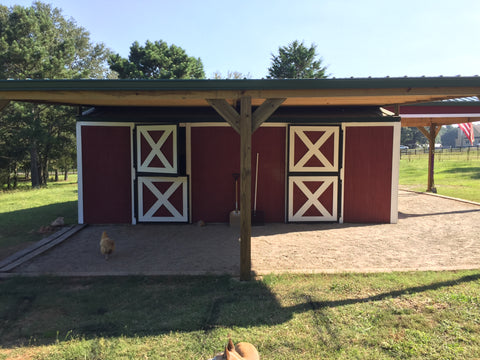Mud on horse farms seems like an inevitability in the wet season, but it doesn’t have to be! You don’t have to use trial and error to figure out how to make your horse paddocks mud-free. It’s all been done before and there are some tried and true principles that just work.
First, we have to know why horse paddocks get so muddy in the high traffic areas such as smaller pens and gateways. Mud occurs in horse areas for two reasons. First, horses exert a large amount of force and a small point of pressure. This is because they are large, heavy creatures with small, hard feet. The effect of hooves on soft ground destabilizes the surface and causes deep displacement of the footing. The more steps they take in one place, the worse the effect is.
Second, horses are actively creating their own mud every day! That’s right, horse manure is a wet organic matter that mixes with the ground to create the perfect mud substance that holds moisture and is slippery and heavy. Unbelievably, horses create 50 pounds of this stuff per day and apply it directly to the paddock surface. Thanks guys…
Don’t despair though, there’s a solution to both sides of the problem.
Step One: Create a high traffic management area.
Often called a dry lot, winter paddock, sacrifice area, or confinement area, these smaller paddocks do the job of saving your pastures and the rest of your farm from turning into a mud pit in the rainy season. It’s important that horses spend their outside time in this space, rather than on your pastures, during the winter and when pastures are grazed below 3” to keep the grass healthy enough to prevent mud and erosion.
The Snohomish Conservation District recommends a minimum of 400 square feet for this space. What your horse needs depends a lot on his breed, age, and activity level, but we usually recommend sizing your area 3-6 times the minimum, if you have space for it, to allow for greater freedom of movement.
Because this space will be subject to high hoof traffic during the wet months, you will have to augment your footing and drainage in this area to keep it from getting muddy.
Slope the ground away from the gate, shelter, or feeder to get water moving away from the areas where your horse will be standing most. If you have a shelter or barn roof that drains into your paddock, install gutters and downspouts to keep the roof water out of your paddock.
Consider a solution like Lighthoof, which stabilizes your paddock base to permanently keep mud from forming and repair existing mud problems. Lighthoof’s flexible plastic panels install right over the existing ground and hold gravel in place in little pockets to create a firm surface with excellent traction. This reduces the amount of gravel you need to use to create a mud-free paddock and holds it together for the long term to prevent it from getting mixed into mud or washed out by rainwater.

Step Two: Maintain the area for optimal horse health.
Once you’ve created your winter paddock, you will have to manage that area to keep it healthy and pleasant for your horse. Consider boredom management tricks such as providing hay in a slow feeder, hanging toys or scratching posts, or orienting your management area in a track shape around a center green belt to encourage movement.
Make sure water and feed is convenient to the paddock, as well as equipment for mucking out the paddock. We recommend mucking out the paddock thoroughly on a daily basis. A very large paddock can be done every couple of days.
Manure which is left to break down on the paddock surface creates a layer of bacteria rich organic matter which turns to mud, harbors bacteria, and promotes parasite reinfection.
Mucking out a muddy paddock is darn near impossible. If you’ve ever tried dragging a full wheelbarrow through ankle deep mud or attempted to separate each horse apple from the sticky rutted ground, you know what I’m talking about!
The nice thing about Lighthoof panels is that they create a firm, easy to pick surface that can also support equipment such as an atv or tractor if that’s part of your maintenance fleet. Installing Lighthoof in your high traffic area can not only fix the mud problem, it will make maintaining and removing organic matter possible on a routine basis.
So that’s really all there is to it. Sound simple right? Create your winter paddock. Set it up for drainage and mud-free footing. Use your winter paddock. Stay disciplined! It’s so tempting to let them out on that mid-autumn sunny day, but resist the urge!! Finally, maintain organic matter buildup by mucking your paddock close to daily. A paddock with a firm, smooth base and footing will make this easier, so consider a solution like Lighthoof to create the best base for your area.





Leave a comment
This site is protected by hCaptcha and the hCaptcha Privacy Policy and Terms of Service apply.